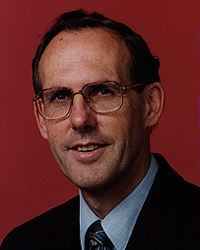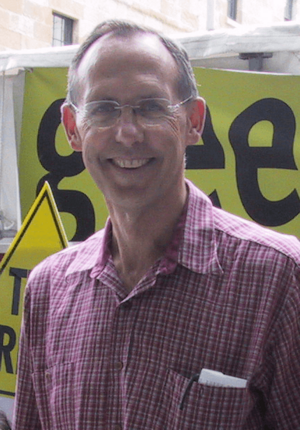Bob Brown facts for kids
Quick facts for kids
Bob Brown
|
|
|---|---|
 |
|
| Leader of the Australian Greens | |
| In office 28 November 2005 – 13 April 2012 |
|
| Deputy | Christine Milne |
| Preceded by | No immediate predecessor |
| Succeeded by | Christine Milne |
| Leader of the Australian Greens in Tasmania |
|
| In office 13 May 1992 – 13 March 1993 |
|
| Deputy | Christine Milne |
| Preceded by | Party established |
| Succeeded by | Christine Milne |
| Senator for Tasmania | |
| In office 1 July 1996 – 15 June 2012 |
|
| Succeeded by | Peter Whish-Wilson |
| Member of the Tasmanian Parliament for Denison |
|
| In office 4 January 1983 – 12 February 1993 |
|
| Preceded by | Norm Sanders |
| Succeeded by | Peg Putt |
| Personal details | |
| Born |
Robert James Brown
27 December 1944 Oberon, New South Wales, Australia |
| Political party | Greens (since 1992) |
| Other political affiliations |
Green Independents (1982–1992) United Tasmania Group (1970s) |
| Residences | Hobart, Tasmania, Australia |
| Education | Coffs Harbour High School Blacktown Boys High School |
| Alma mater | University of Sydney |
| Occupation | General practitioner (Self-employed) |
| Profession | Physician Politician |
| Website | bobbrown.org.au |
Robert James Brown (born 27 December 1944), known as Bob Brown, is a famous Australian environmentalist, former doctor, and politician. He was a senator in the Australian Senate and the leader of the Australian Greens, a political party focused on environmental issues.
Brown was first elected to the Senate in 1996. He helped form the first group of Australian Greens senators. He was re-elected in 2001 and 2007. During his time in politics, he worked to protect large areas of wilderness in Tasmania. He led the Australian Greens for many years, during which the party became more popular.
On 13 April 2012, Brown stepped down as leader of the Greens. He also announced he would be leaving the Senate, which he did on 15 June 2012.
Contents
Early Life and Becoming a Doctor
Bob Brown was born in Oberon, New South Wales. He has a twin. He went to several schools, including Coffs Harbour High School and Blacktown Boys High School. In his final year, he was elected school captain.
After high school, Brown studied medicine at the University of Sydney. He earned a degree in medicine and surgery.
A Doctor and an Activist
Brown started his career as a doctor at the Royal Canberra Hospital. He later worked in hospitals in Darwin and Alice Springs. In Alice Springs, he met a surgeon who had kayaked down rivers in Tasmania, which sparked his interest in the island.
In 1970, Brown moved to London and worked in two hospitals. He was the doctor on duty at St Mary Abbots Hospital when the famous musician Jimi Hendrix was brought in. Brown later explained that Hendrix had already been dead for several hours and was officially pronounced dead by another doctor.
In 1972, Brown moved to Tasmania and worked as a family doctor in Launceston. He quickly became involved in the state's environmental movement. He joined a group called the United Tasmania Group, which was Australia's first "green" political party. He also spent two years searching for the Thylacine, or Tasmanian tiger, which was believed to be extinct.
In 1976, he protested the arrival of a nuclear-powered warship in Hobart by fasting for a week on top of Mt Wellington.
Working to Protect Tasmania

In 1978, Brown became the director of the Tasmanian Wilderness Society. He became a leader in the campaign to stop the building of the Franklin Dam. This dam would have flooded the beautiful Franklin River valley.
Brown was one of 1,500 people who protested the dam. He spent 19 days in prison for his part in the protests. The day he was released in 1983, he became a member of Tasmania's parliament. The campaign was a success, and the Australian government stepped in to protect the Franklin River that same year.
During his time in the Tasmanian parliament, Brown introduced many new ideas. He worked on laws for freedom of information, animal welfare, and making Tasmania a nuclear-free zone. In 1987, he tried to ban semi-automatic guns, but the idea was voted down. Nine years later, a similar ban was passed by the federal government after the Port Arthur massacre.
In 1989, Brown became the leader of the Tasmanian Greens. He worked with the Labor Party for a time, but they later disagreed on issues related to forests. In 1993, he left the Tasmanian parliament to run for the federal parliament, but he was not successful at that time.
A Voice for the Environment in Federal Parliament

Brown was elected to the Australian Senate for Tasmania in 1996. He often spoke out against the government of Prime Minister John Howard. He supported environmental and human rights issues, including for people in Tibet, East Timor, and West Papua.
After being re-elected in 2001, Brown became well-known for his strong opposition to Australia's involvement in the 2003 invasion of Iraq.
Standing Up for Beliefs
When U.S. President George W. Bush visited Australia's Parliament in 2003, Brown and another Greens senator, Kerry Nettle, interrupted his speech. They held up signs about two Australian citizens being held at Guantánamo Bay, Cuba. Because of this, Brown and Nettle were suspended from parliament for 24 hours. This meant they could not attend a speech by Chinese President Hu Jintao the next day.
Fighting for Forests
In 2004, a logging company called Gunns Limited tried to sue Brown and other activists for millions of dollars. The company claimed their campaigns were hurting its business. The case was eventually dropped.
In 2005, Brown took a government-owned company, Forestry Tasmania, to court. He wanted to protect Tasmania's Wielangta forest from being completely logged. He argued that logging was harming endangered species like the Swift parrot. A judge first ruled in Brown's favor. However, this decision was later overturned by a higher court.
Brown was ordered to pay $240,000 in legal costs. He said he could not afford it, which could have cost him his Senate seat. But after he announced this, over 1,000 people donated money to help him pay the bill in just a few days.
Life After Politics
Brown resigned as leader of the Greens on 13 April 2012, and left the Senate on 15 June 2012. His work for the environment did not stop.
In 1990, Brown started the Australian Bush Heritage Fund, which is now called Bush Heritage Australia. It is a non-profit group that buys and protects Australian bushland. In 2011, he donated his own 14-hectare property in the Liffey Valley, Tasmania, to the organization.
The Bob Brown Foundation
Brown started the Bob Brown Foundation to promote environmental awareness. The foundation gives out awards to people who work hard to protect the environment. The "Young Environmentalist of the Year" and "Environmentalist of the Year" awards have been given to many Australian activists.
Continuing Activism
Since leaving politics, Brown has stayed very active. He has supported campaigns to protect the Kimberley region in Western Australia from industrial development. In 2013, he became a director of the Australian chapter of the Sea Shepherd Conservation Society, a group that protects marine life. He stepped down in 2014.
In 2016, he was involved in a protest to stop logging in Tasmania's Lapoinya Forest. He challenged the law used against protesters in Australia's High Court. In 2017, the court agreed that parts of the law were invalid.
Awards and Recognition
In July 2012, Brown was added to the Hall of Fame at Coffs Harbour High School. He has received many awards for his work, including:
- The Australian newspaper 'Australian of the Year' (1983)
- IUCN Packard Award for conservation (1984)
- UNEP Global 500 Roll of Honour (1987)
- Goldman Environmental Prize (1990)
- BBC Wildlife magazine 'World's Most Inspiring Politician' (1996)
- National Trust Australian National Treasure (1998)
- Rainforest Action Network Environmental Hero (2006)
- Australian Peace Prize (2009)
- Australian Humanist of the Year (2010)
Images for kids
-
Adam Bandt, Brian Walters and Brown during the campaign for the 2010 Victorian state election
See also
 In Spanish: Bob Brown (político) para niños
In Spanish: Bob Brown (político) para niños





